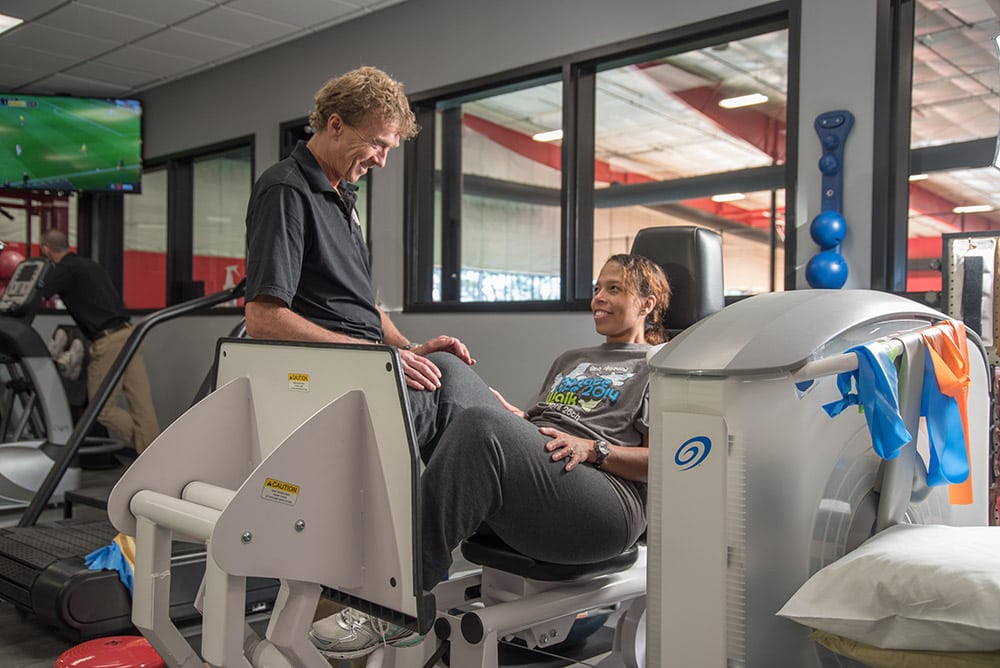By Per Kristian Moerk, PT, DPT, Manager, Outpatient and Sports Physical Therapy
My childhood in Norway was filled with lots of exercise activities with my family. I’ve continued that tradition with my own children. While we may not have the opportunity here in the Piedmont to cross-country ski (something I enjoyed doing with my mother when I was growing up), we do have a variety of activities we like to participate in as a family. One of our favorite things to do together is run. It’s an exercise that has numerous health benefits, as well as opportunities for family fun.
Why Running?
Running is one of the easiest and best activities for getting in shape. It aids in weight loss and has many cardiovascular benefits. And for children, running can be a great method for expending excess energy and staving off childhood obesity. While walking can be a rewarding physical activity—especially for those who are out of shape or have physical limitations—it will not offer the same fitness advantages as running. If you are walking, be sure that you’re doing so quickly and intensely enough to keep your heart rate up. As you and/or your child get more energetic, consider running. It won’t be long before you start noticing the positive changes in your health and energy.
Finding Time
These days, we’re busier than ever. That’s why any exercise activity must be intentional. At the beginning of each week, schedule time for running—or any other exercise of your choice—on the family calendar. It’s also important to coordinate your schedule with your spouse. Often, people neglect exercise time because they believe it takes away from their family time. But when you’re exercising together, that is family time.
Setting an Example
You are the best mentor for your children. If you’re only driving your children to practice and never participating in exercise with them, or even on your own, they may get the message that exercise is not an important part of adult life. On the other hand, if they see that you have an active lifestyle, they’ll more naturally develop one of their own—and will likely extend that example to their own children one day.
Modeling a healthy lifestyle can and should start early. Even if your child is very young, you can put him or her in a jogging stroller to accompany you on your daily runs. Not only can this be fun for your young one, it sets the expectation that running is a normal part of your family’s lifestyle.
Getting Your Child Involved
If your child is still fairly young, you can let him or her run along side you for short distances and then get back in the jogging stroller when he or she gets tired. As your child gets older, be encouraging, but allow your child to set the pace. Running can be fatiguing. That’s a normal part of the experience, but it may be new to children who aren’t used to that much activity. Always offer positive feedback. If you make it a good experience for your child, he or she will want to do it again.
Be Prepared
It’s essential to invest in good running shoes for your child if he or she is running regularly. Also make sure your child is dressed properly for the conditions. If it’s a cooler time of the year, ensure your child is dressed in layers that will keep him or her warm, but that can also be easily removed, if necessary.
Always ensure your child has water when running. Proper hydration is necessary for this activity.
Participating in 5Ks and Other Races
Racing can be fun for the entire family. For kids, there really is no age limit. However, you don’t want your child to start out running a distance he or she has never run before. If you sign up for a race, spend the weeks or months beforehand training with your child, helping him or her to run longer and longer distances. Training is most effective when you mix it up a bit and break it into small goals. Online training guides can be very helpful, but ultimately, they’re just suggestions— do what works best for you and your kids.
Be sure to set realistic goals. If this is the first race for you or your child, make finishing the race your primary goal. As you go on to participate in other races, you can start setting timing goals. It’s also important to remember that walking (or a combination of walking and running) is allowed at any race. Your child should feel free to slow his or her pace or rest whenever necessary.
If your child has a preexisting medical condition, like asthma, check with your family’s pediatrician first. For most healthy children, however, racing can be a beneficial activity. Just don’t forget to bring water along to the race!
To schedule an appointment with a pediatrician, contact 336-716-WAKE (9258). Brenner Children’s Hospital serves all children, regardless of insurance status.
*Sponsored by Brenner Children’s Hospital
















